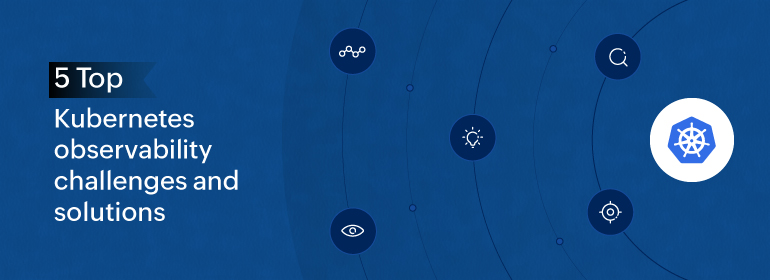5 Top Kubernetes Observability Challenges and Solutions

Observability in IT refers to the ability to measure a system's internal functioning by studying its signals from the outside. Modern IT observability is achieved through three kinds of telemetry: metrics, traces, and logs. Metrics aggregate events to gauge a system’s current state. Tracing tracks the progress of each transaction to not only measure performance but also debug the problem. On the other hand, logs record each event, which can help during troubleshooting.
In the post-cloud era, modern IT has been rapidly moving towards newer methods of abstraction, such as containerization, to make the most of available resources and ensure the maximum value of computing resources. Kubernetes are now the most-used container orchestration platform, and are used to deploy high-performance applications on a large scale. Kubernetes simplifies the process of centralizing the way containers are spawned, reused, or retired, making your IT infrastructure react to demand in real-time. They also present several challenges for DevOps and IT professionals, especially on the monitoring front.
Need for a Kubernetes observability tool
Kubernetes increases the number of moving parts in your IT infrastructure, adding another dimension to monitoring complexity. Since containers are abstract, dynamic, and ephemeral, Kubernetes can be overwhelming for IT teams to observe. To tackle this, a move is required from a piecemeal approach to IT monitoring to a modern observability tool that can comprehend the nature of Kubernetes and extract data to make it comprehensively observable.
A Kubernetes observability tool converges telemetry data, also known as the three pillars of observability, on a single platform. Only comprehensive Kubernetes observability can give IT platform engineers the pulse of their deployment’s current state while also ensuring adequate data to troubleshoot downtime issues without becoming overwhelmed. A Kubernetes monitoring tool should flag anomalies across deployment, identify vulnerabilities and trends to take proactive action and present the data in a palatable, clutter-free, real-time, customizable dashboard to derive actionable insights.
Major challenges in Kubernetes observability and solutions
Gaining clarity: With great clarity comes great control. A Kubernetes observability platform goes beyond Kubernetes monitoring in several ways. While Kubernetes monitoring means individually tracking the uptime and performance of clusters, nodes, containers, pods, and workloads running within, Kubernetes observability provides you with the big picture. Kubernetes observability helps you get visibility from the macro level to the granular level of how the code behaves during runtime while also gauging the health and stability of the deployment to unearth actionable insights.
Cutting the clutter: Kubernetes observability is needed to cut the clutter and understand how the myriad components of a Kubernetes deployment, such as pods, containers, and microservices, work within the dynamic nature of the platform itself to unearth bugs, unravel patterns, and untangle the system to make maintenance, change management, and troubleshooting easy.
Continuous understanding: One minute is a long time with Kubernetes. The orchestration platform juggles computing resources in mind-boggling ways to match the demand. That is why metrics on storage limits or container numbers gathered minutes ago don’t reflect the current state of your Kubernetes deployment. Neither do configurations that existed an hour ago. As the metrics, logs, and traces date quickly and become useless, you need an observability platform that keeps your observability data in real time, while also keeping track of the historic changes as a reference for better understanding.
Centralized viewing: A Kubernetes observability platform like Site24x7 helps ensure a healthy deployment by providing deep, real-time insights into resource usage to identify issues such as stranded resources, failed nodes, pods, and workloads within. Such a tool ensures end-to-end visibility into your cluster by providing accurate, easy-to-understand metrics per inventory, namespace, and clusters.
Context and correlation: Use Site24x7’s Kubernetes logs and events feature, which includes pod logs, audit logs, event logs, and application logs, to drill down to any issue that occurs within your environment on your timeline. When the metrics, traces, and logs are correlated and viewed on specific, customized dashboards, you can instantly gain actionable insights backed by multi-dimensional context.

Conclusion
As applications running on Kubernetes are extraordinarily dynamic and run on several layers of abstractions orchestrated by the container orchestration platform, their observability becomes indispensable to ensure their success. Kubernetes sits at the intersection of bare-metal or virtual computing infrastructure and the services that house your apps. Further, due to the fluid nature of orchestration, it is hard to see inside a Kubernetes container, especially when they die, the data within goes beyond recovery.
A comprehensive Kubernetes observability tool becomes necessary to clarify what happens to each component in real time, cut the clutter in fast-accumulating monitoring data, continuously understand the big picture of your deployment, and view them centrally on a single platform to correlate the deluge of data to grasp the context at all time. Such an end-to-end, specialized, dedicated observability platform is essential to go beyond the vanilla metrics exposed by Kubernetes to gain the most out of modern IT.
Site24x7 offers out-of-the-box observability, organization, alerts, and forecasts to ensure the top performance of your clusters, nods, and pods. Site24x7 Kubernetes observability is easy to install and auto-discovers all components to empower your team with centralized visibility on a unified dashboard. Try the Site24x7 Kubernetes monitoring tool today.
Comments (0)